Categories > Guides and Tips
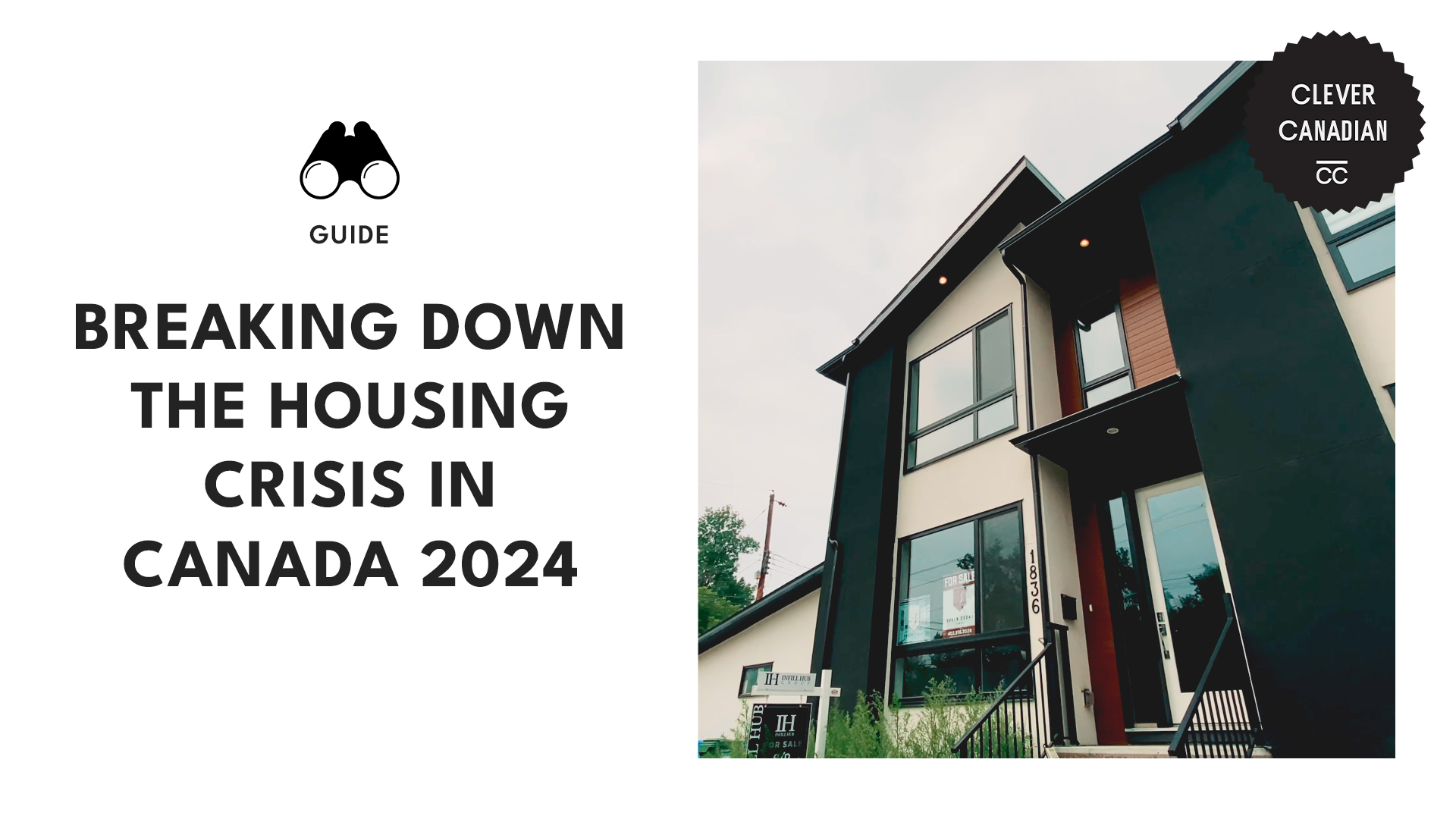
Breaking Down the Housing Crisis in Canada 2024
- Key Insights
- Housing Challenges Per Region in Canada
- Canadian Cities with the Worst One-Bedroom Affordability
- Demographics Affected by Housing Crisis in Canada
- Disparities in Shelter Use by Gender in Canada
- Disparities in Shelter Use by Age in Canada
- Disparities in Shelter Use by Indigenous Identity in Canada
- The Consequences of the Housing Crisis in Canada
- Interventions and Solutions for the Housing Crisis in Canada
- The Future of the Housing Crisis in Canada
- References
Key Insights
| • Statistics Canada reports that 34% of Canadians face financial hardship due to housing costs, while 31% had to alter moving plans. • CMHC data highlights a growing financial strain on homeowners. The monthly cost of owning a 3+ bedroom condominium rose to $4,004.09 in 2023, while rental prices increased to $1,488.15 for two-bedroom apartments and $1,050.30 for bachelor units. • In a regional breakdown by Statistics Canada, 74% of Ontarians face housing challenges, the highest among the provinces. Meanwhile, Quebec recorded the lowest rate at 56%. • Data from Home Network reveals that Toronto renters spend 48.55% of their income on rent. It’s followed by Vancouver at 46.07% and Halifax at 40.99%. • Men account for 67.8% of shelter users, women for 31.1%, and 1.1% are gender diverse, per the National Shelter Study. • According to Reuters, income growth of 2.3% since the pandemic has not kept pace with housing costs. This leaves affordability as a long-term issue |
The housing crisis in Canada has been an ongoing issue for several years, and according to Statistics Canada, it has only intensified as of 2024. 45% of Canadians expressed concern about their ability to afford housing due to rising costs.
The Canadian Mortgage and Housing Corporation (CMHC) states that condominium ownership costs have risen significantly. This is particularly true for units with three or more bedrooms, which reached an average monthly cost of $4,004.09 in 2023.
Rental costs have also increased. Two-bedroom apartments average $1,488.15 per month, and bachelor units average $1,050.30.
Still, the gap underscores the mounting financial burden on homeowners compared to renters over the past decade.
To provide a clearer picture of these trends, the chart below visualizes the sharp rise in ownership costs, particularly for larger apartments. Compare it to the more gradual increase in rental expenses.
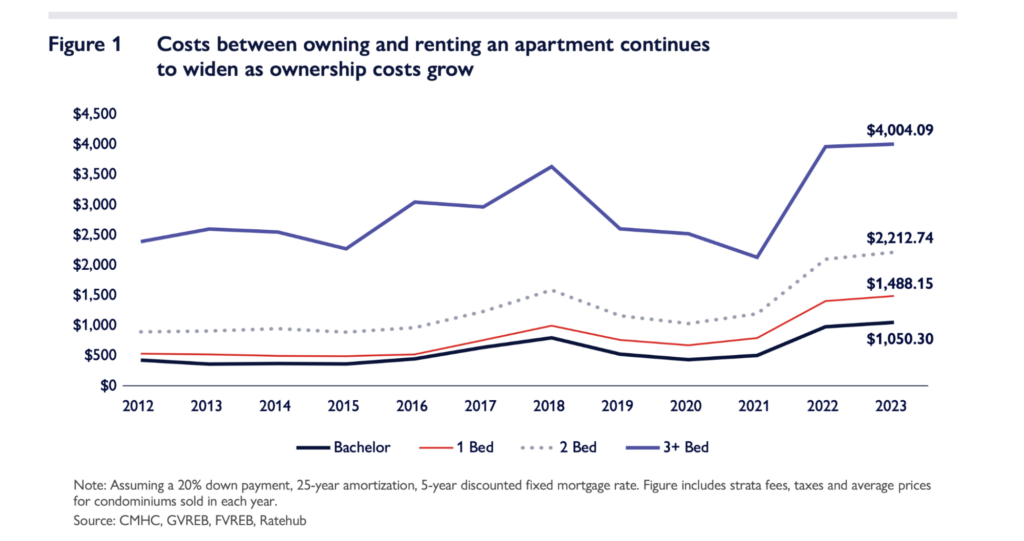
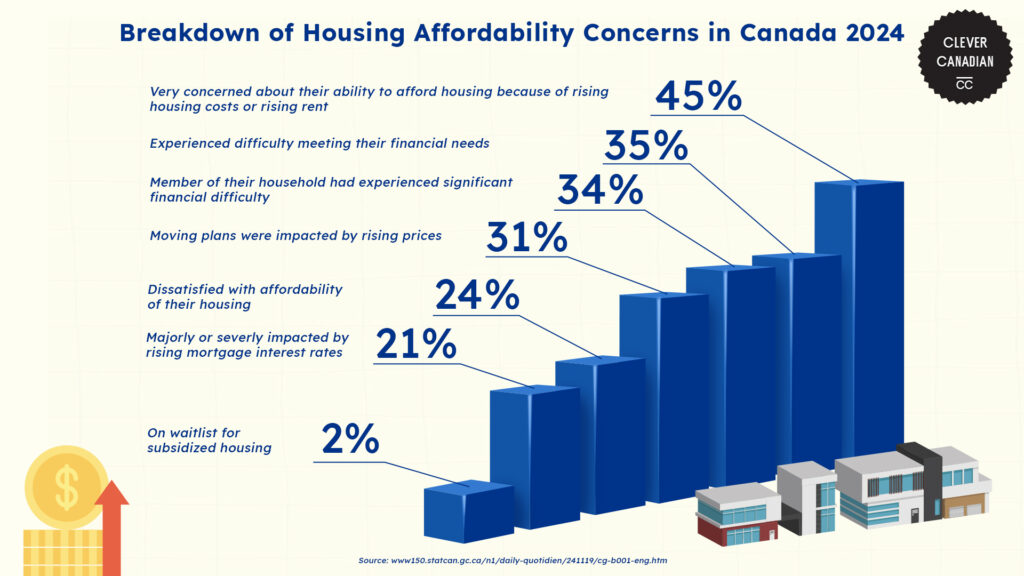
According to a recent Canadian Social Survey, about one-third of Canadians reported difficulty meeting essential financial needs in the past year. Those needs include housing, food, and transportation.
Additionally, 34% indicated that housing costs caused significant financial hardship for someone in their household. Meanwhile, 31% had to alter their moving plans due to affordability issues.
Housing Challenges Per Region in Canada
The housing crisis affects provinces and territories differently. Below is a table showcasing the percentage of people per province facing one or more housing challenges.
| Province | Percentage experiencing housing challenges |
| Ontario | 74% |
| British Columbia | 72% |
| Prairies | 69% |
| Atlantic region | 65% |
| Quebec | 56% |
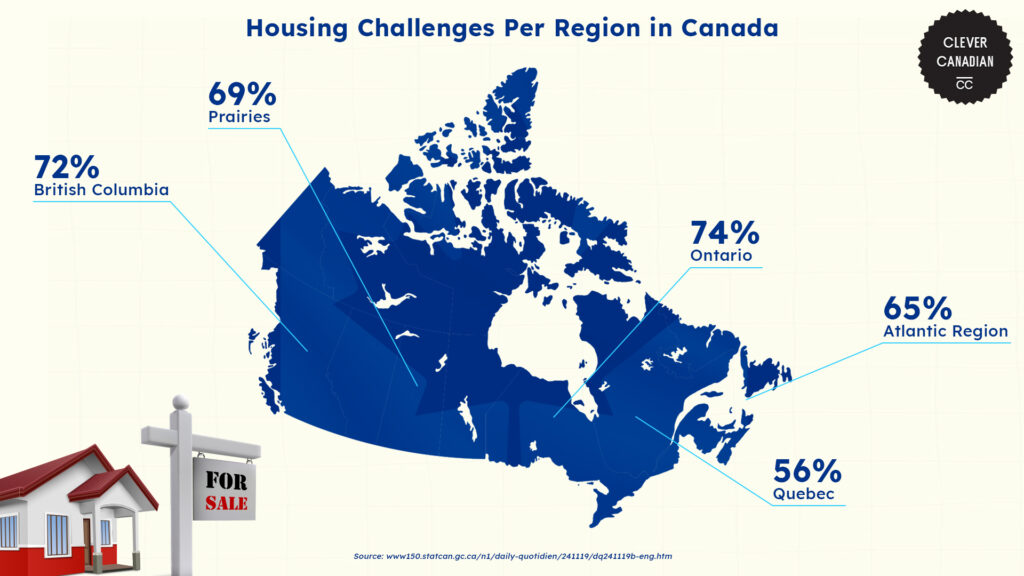
According to Statistics Canada, housing challenges affect Canadians differently depending on where they live. Ontario has the highest percentage of residents affected, at 74%.
British Columbia isn’t far behind with 72%. Prairies see 69% dealing with similar struggles, while the Atlantic region reports 65%.
Quebec has the lowest percentage of people affected by housing challenges, at 56%.
Canadian Cities with the Worst One-Bedroom Affordability
A recent analysis by Home Network reveals how much annual income residents in various cities spend on rent for a one-bedroom apartment.
The figures offer a snapshot of the financial strain renters face across the country, with some cities requiring nearly half of residents’ earnings just to cover rent.
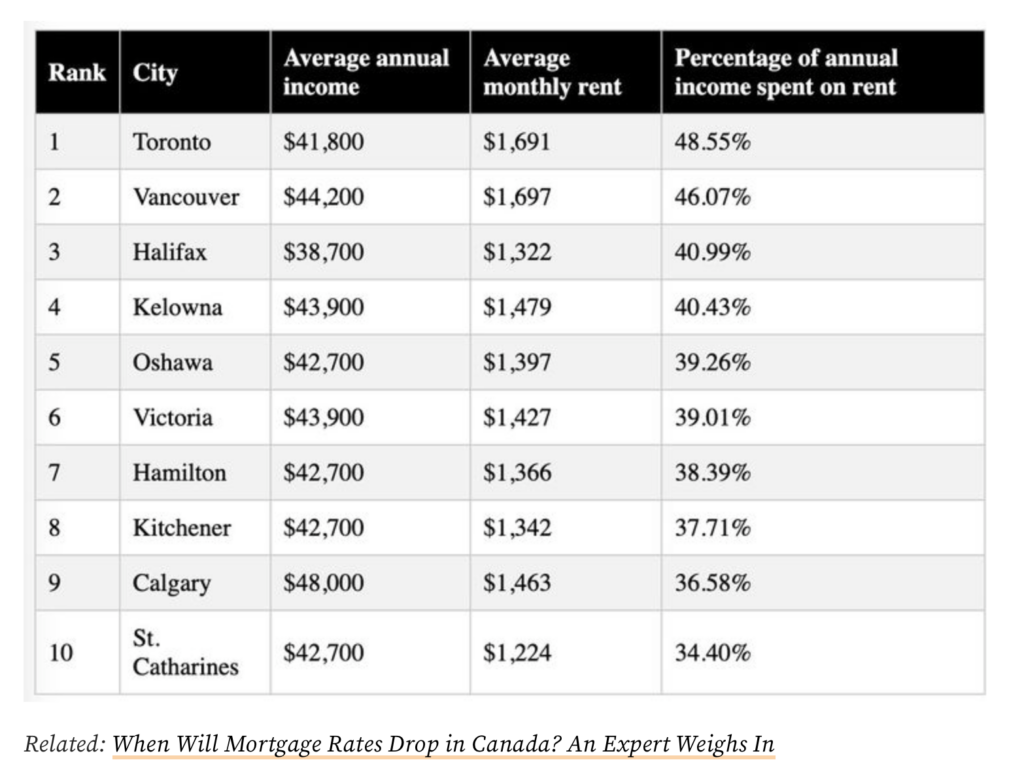
Toronto has the worst affordability. Residents spend 48.55% of their average annual income of $41,800 on rent, which averages $1,691 monthly.
Vancouver is the second-least affordable city, with residents earning $44,200 spending 46.07% on rent. This averages to $1,697 monthly.
Halifax ranks third, with renters dedicating 40.99% of their $38,700 income to rent. Other cities like Kelowna (40.43%), Oshawa (39.26%), and Victoria (39.01%) also show significant financial burdens.
Meanwhile, Calgary (with the highest average income of $48,000 on the list) has renters spending 36.58% on an average monthly rent of $1,463.
St. Catharines rounds out the list with the lowest percentage, where 34.40% of the average income of $42,700 goes toward rent.
Demographics Affected by Housing Crisis in Canada
The Canadian Observatory on Homelessness defines homelessness as lacking safe, permanent, and appropriate housing, often due to the inability to afford such housing.
A report by United Way Centraide Canada highlights that rising rents and soaring housing prices have pushed affordability to a breaking point. This has led more Canadians to go to support services such as homeless shelters.
This part will illustrate how these housing challenges affect Canadians, broken down by gender, age groups, and Indigenous populations.
Disparities in Shelter Use by Gender in Canada
| Gender | Percentage |
| Male | 67.8% |
| Female | 31.1% |
| Gender diverse | 1.1% |
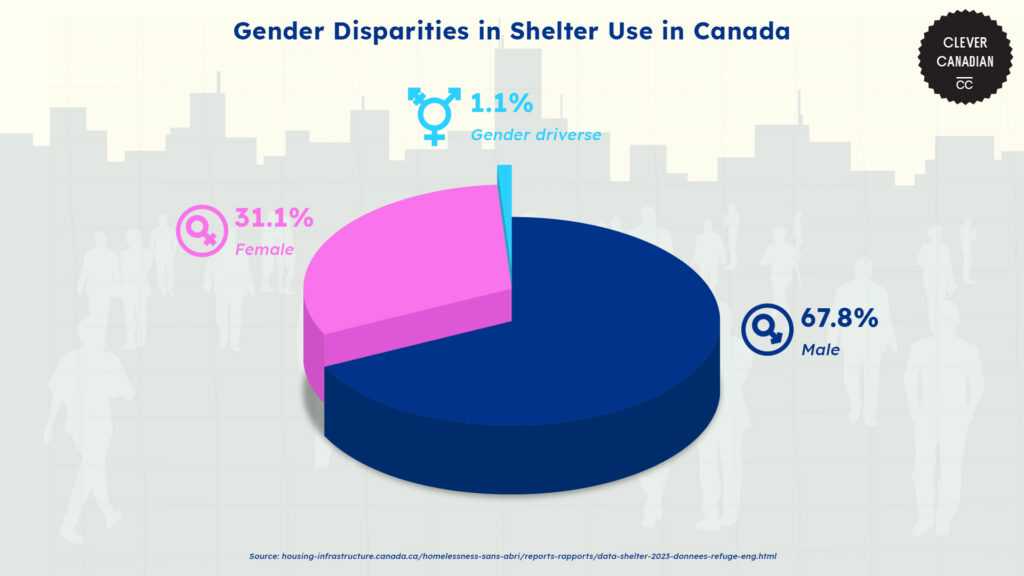
As per the 2023 data report by The National Shelter Study, men make up 67.8% of shelter users, while women account for 31.1% and 1.1% identify as gender diverse.
This shows that men are the predominant demographic in homeless shelters, potentially due to factors like lack of targeted services for men or social expectations that discourage them from seeking help.
Women, though a smaller proportion, often face unique vulnerabilities related to domestic violence and family instability, contributing to their housing challenges.
Disparities in Shelter Use by Age in Canada
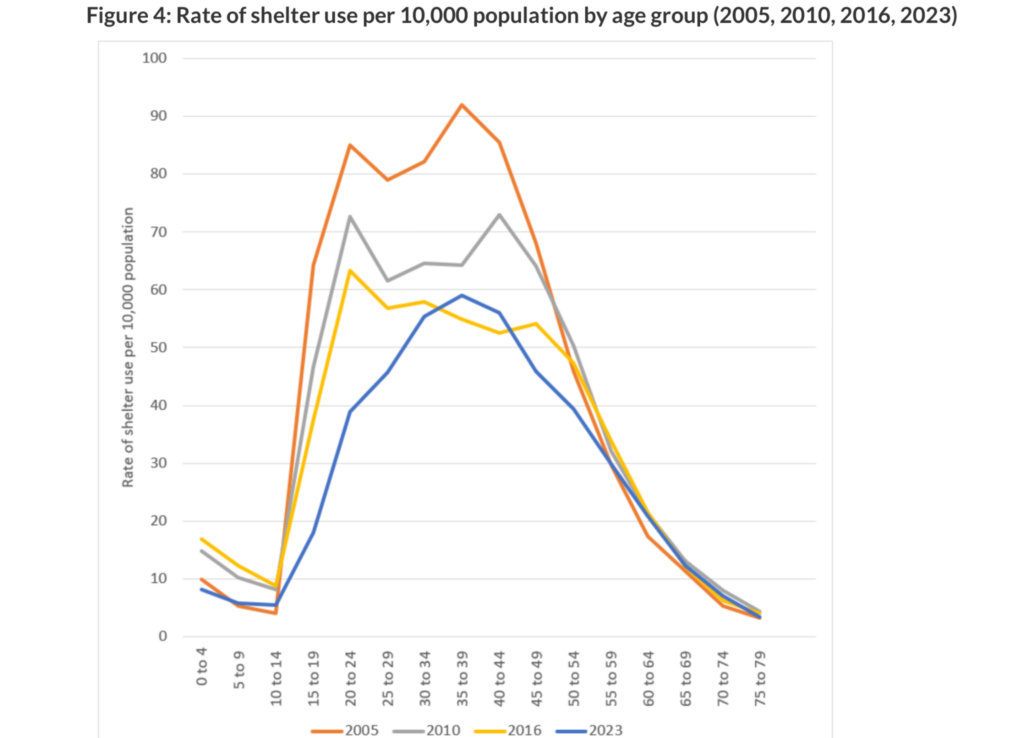
The shows shelter use rates per 10,000 population by age from 2005 to 2023. 61.3% of users are typically aged 25-49, making up the largest groups.
It’s followed closely by those aged 50-64, which makes up 19.2% of the total population. Seniors (65+) and children (0-16) have the lowest rates at 4.2% and 3.5% respectively.
Youth usage (13-24) has also steadily declined since 2015. Rates for most age groups have actually dropped significantly since 2005, particularly among youth and young adults.
Between 2016 and 2023, a slight increase was seen in shelter use for those aged 35-39 and 40-44. Shelter use patterns have shifted, with peaks moving from younger age groups (20-24) in earlier years to the 35-39 age group in 2023.
Disparities in Shelter Use by Indigenous Identity in Canada
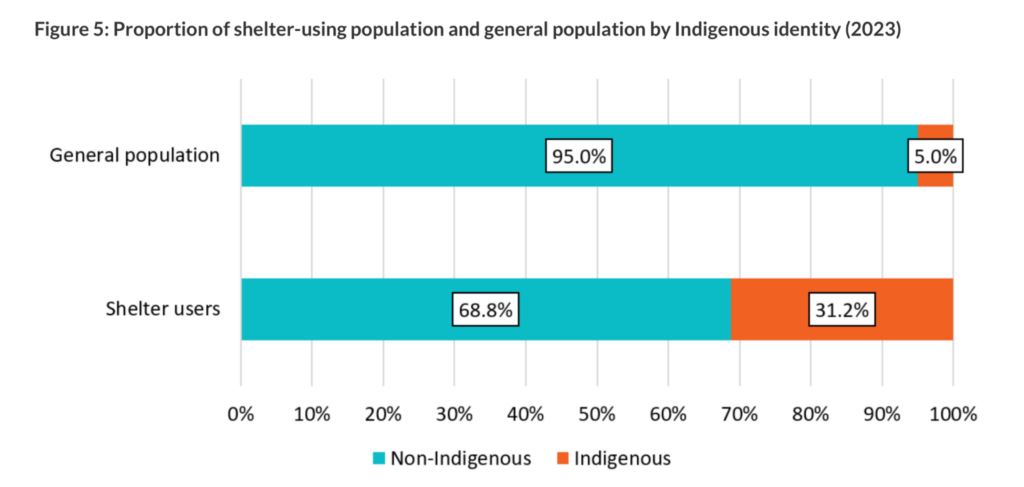
While Indigenous Peoples make up only 5.0% of the Canadian population, they accounted for 31.2% of shelter users in 2023. This proportion has remained consistent since 2015.
The Consequences of the Housing Crisis in Canada
Canada’s housing crisis is profoundly affecting individuals and families. According to a survey by the Canadian Alliance to End Homelessness, nearly three-quarters of Canadians feel that housing costs have significantly increased their stress levels.
| Consequence | Percentage of Canadians |
| Financial stress | 43% |
| Low quality of life | 35% |
| Mental health challenges | 33% |
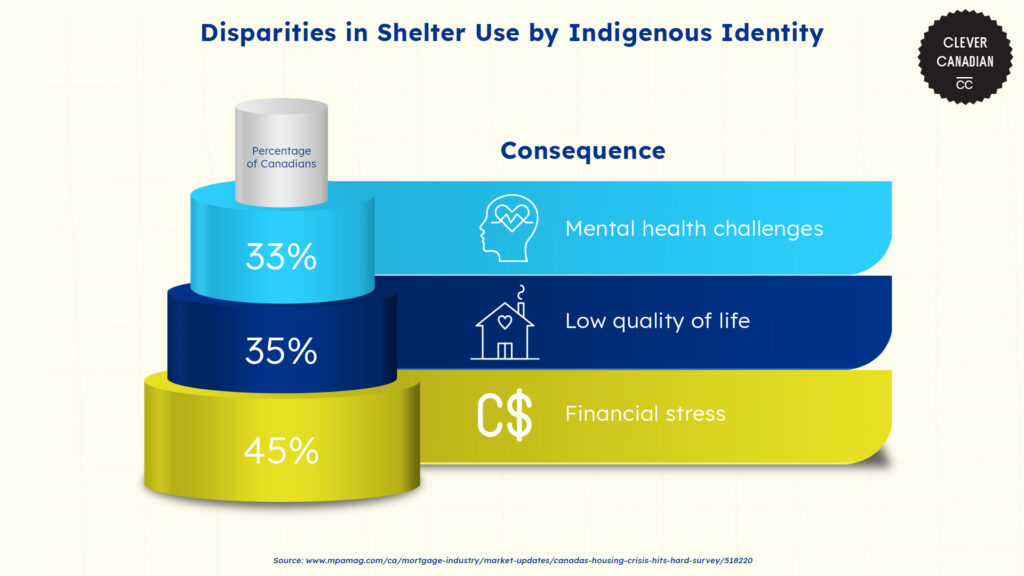
According to a survey by the Canadian Alliance to End Homelessness, 43% of Canadians report experiencing financial stress due to rising housing costs.
Additionally, 35% say their quality of life has declined, as housing affordability limits their ability to meet other essential needs. Meanwhile, mental health challenges were reported by 33%.
Interventions and Solutions for the Housing Crisis in Canada
Addressing Canada’s housing crisis requires innovative and collaborative solutions. The National Housing Strategy, outlined by the Canadian government, focuses on long-term interventions.
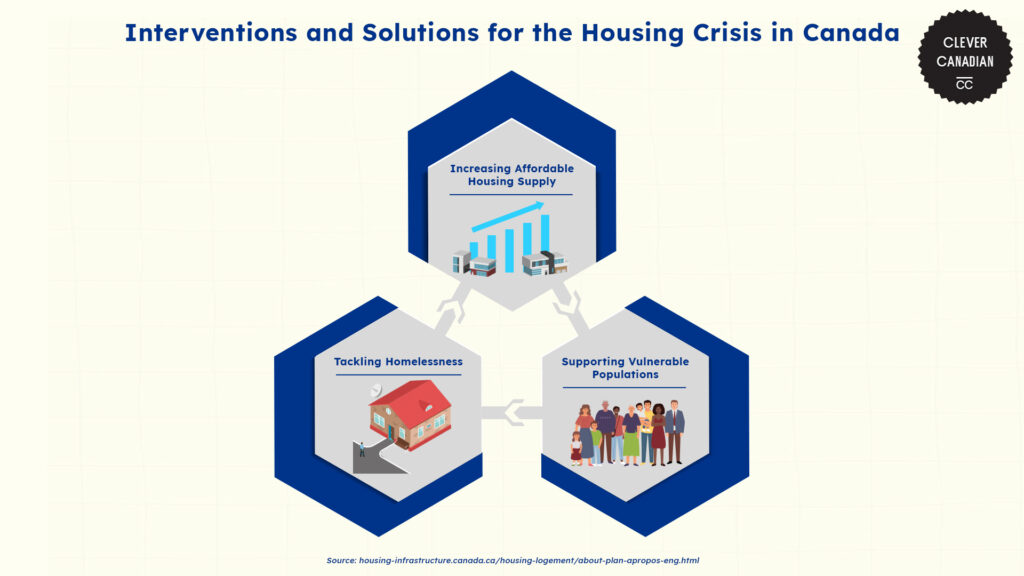
Their key focus is increasing the supply of affordable homes with programs like the Affordable Housing Innovation Fund and National Housing Co-Investment Fund. These aim to create over 150,000 affordable units using innovative building solutions and partnerships.
The strategy also prioritizes vulnerable populations, including seniors, Indigenous Peoples, and individuals with disabilities. This is through initiatives like the Federal Community Housing Initiative, which preserves housing for those most at risk.
To address homelessness, efforts such as the Reaching Home Initiative and Rapid Housing Initiative provide solutions that include converting existing spaces into affordable housing.
These combined measures aim to build a more inclusive and sustainable housing landscape across Canada.
The Future of the Housing Crisis in Canada
Canada’s housing affordability crisis shows no signs of quick resolution, with experts predicting that high housing costs may persist for years despite recent interest rate cuts.
According to a report from Reuters, while rate adjustments have slightly improved affordability, the gap between income growth and housing prices continues to widen.
Since April 2020, housing prices have increased by more than 30% on average, while average incomes have only increased by 2.3%.
Reports suggest that affordability will remain a challenge, so systemic interventions such as increasing housing supply and reforming zoning laws are essential for long-term accessibility.
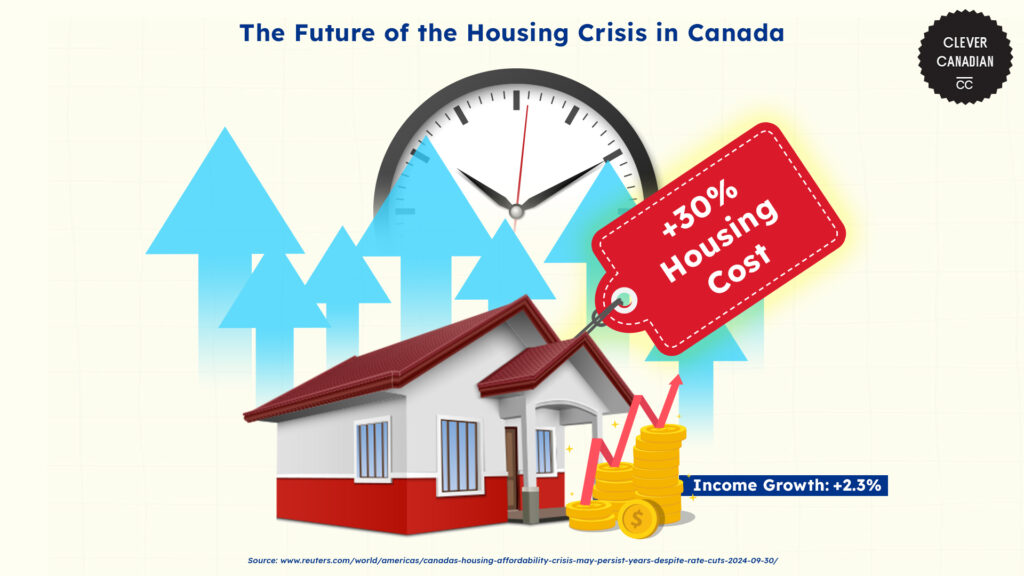
References
- Canada, I. (2024, November 29). Housing, Infrastructure and Communities Canada – Homelessness data Snapshot: The National Shelter Study 2023 update. https://housing-infrastructure.canada.ca/homelessness-sans-abri/reports-rapports/data-shelter-2023-donnees-refuge-eng.html
- Canada, I. (2024a, August 13). Housing, Infrastructure and Communities Canada – About the plan. https://housing-infrastructure.canada.ca/housing-logement/about-plan-apropos-eng.html
- Devswoon. (2024, November 15). Homelessness, housing, and poverty: Canada’s urgent crisis. United Way Centraide Canada. https://www.unitedway.ca/homelessness-housing-and-poverty-canadas-urgent-crisis/?utm_source
- Explore Canada’s rental landscape in 2023. (2024, January 31). CMHC. https://www.cmhc-schl.gc.ca/blog/2024/canadas-rental-landscape-2023-show-record-low-vacancies-affordability-concerns?utm_source
- Government of Canada, Statistics Canada. (2023, June 16). A review of Canadian homelessness data, 2023. https://www150.statcan.gc.ca/n1/pub/75f0002m/75f0002m2023004-eng.htm?utm_source
- Government of Canada, Statistics Canada. (2024, November 19). The Daily — Housing challenges related to affordability, adequacy, condition and discrimination, August 2 to September 15, 2024. https://www150.statcan.gc.ca/n1/daily-quotidien/241119/dq241119b-eng.htm
- Mendoza, C. (2024, December 16). Canada’s housing crisis hits hard: Survey. Canadian Mortgage Professional. https://www.mpamag.com/ca/mortgage-industry/market-updates/canadas-housing-crisis-hits-hard-survey/518220
- Murray, D. (2024, November 25). The best and worst cities for homebuyers in Canada revealed. Home Network. https://www.homenetwork.ca/best-worst-cities-homebuyers-canada/
- Reuters. (2024, September 30). Canada’s housing affordability crisis may persist for years despite rate cuts. https://www.reuters.com/world/americas/canadas-housing-affordability-crisis-may-persist-years-despite-rate-cuts-2024-09-30/
- Surging demand leads to tightening of Canada’s rental markets. (2023, January 26). CMHC. https://www.cmhc-schl.gc.ca/media-newsroom/news-releases/2023/surging-demand-leads-tightening-canadas-rental-markets?utm_source






